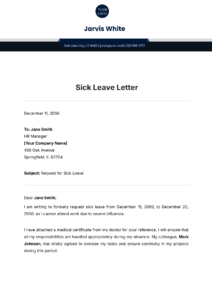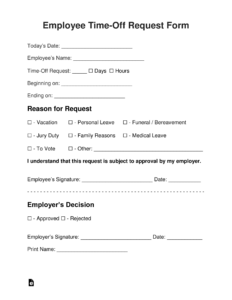Utilizing structured forms for leave requests offers several advantages. It streamlines the process for both employees and supervisors, reduces miscommunication and errors, and creates a documented record for tracking and reporting purposes. This can lead to improved workflow management, better resource allocation, and fairer leave distribution. Furthermore, a well-designed form can ensure compliance with company policies and legal requirements.
This article will explore the key components of effective leave request forms, discuss best practices for implementation, and provide examples to illustrate how these tools can improve workplace efficiency and employee satisfaction. Different types of requests, such as vacation time, sick leave, or personal days, will also be addressed.
Key Components of a Leave Request Form
Effective leave request forms ensure clarity and consistency in absence management. Several key components contribute to their functionality and efficiency.
1: Employee Information: Clear identification of the requesting employee is essential. This typically includes the employee’s full name, employee ID, department, and job title.
2: Date of Request: The date the request is submitted allows for accurate tracking and processing.
3: Dates of Absence: The specific start and end dates of the requested leave period must be clearly indicated. This includes the total number of days requested.
4: Type of Leave: Specifying the reason for the leave, such as vacation, sick leave, personal time, or bereavement, is crucial for accurate record-keeping and compliance with relevant policies.
5: Reason for Leave (Optional): While not always mandatory, providing a brief explanation for the leave can be helpful, especially for longer absences or personal leave requests.
6: Contact Information: Providing contact information, such as a phone number or email address, allows supervisors to reach the employee if needed during their absence.
7: Supervisor Approval: A designated space for supervisor signature or electronic approval signifies authorization of the leave request. This section may also include space for comments or conditions of approval.
8: HR Acknowledgment (Optional): Some organizations may include a section for human resources to acknowledge receipt and processing of the leave request.
Accurate data capture, clear communication, and streamlined processing are the hallmarks of a well-designed leave request form. These components contribute to efficient absence management and ensure that all necessary information is readily available.
How to Create a Leave Request Form
Creating a standardized leave request form promotes consistency and efficiency in managing employee absences. The following steps outline a practical approach to developing a comprehensive form.
1: Determine Required Information: Identify the essential data points needed for effective absence tracking and management. This typically includes employee details, dates of absence, type of leave, and contact information.
2: Choose a Format: Select a format suitable for the organization’s needs. Options include digital forms (e.g., online platforms, spreadsheets), or printable paper documents. Digital formats offer advantages in terms of automation and accessibility.
3: Design the Form: Structure the form logically, grouping related information together. Clear labels and concise instructions ensure ease of use. Ensure the form is accessible on various devices (desktop, mobile).
4: Establish Approval Workflow: Define the approval process, outlining how requests are routed to supervisors and/or human resources. Automated workflows within digital systems can streamline this process.
5: Implement and Communicate: Introduce the new form to employees and supervisors, providing clear instructions on its use. Integrating the form within existing HR systems can enhance adoption.
6: Regularly Review and Update: Periodically review the form’s effectiveness and make adjustments based on user feedback and organizational needs. This ensures the form remains relevant and efficient.
A well-designed form facilitates clear communication, simplifies leave management, and promotes accurate record-keeping. Careful consideration of these steps will contribute to a more efficient and user-friendly process.
Standardized forms for requesting time off are essential tools for effective workforce management. They provide a structured framework for clear communication between employees and supervisors, ensuring all necessary information is captured accurately. This facilitates efficient processing, reduces errors, and contributes to better record-keeping. By streamlining the process, these tools support better resource allocation and fairer distribution of leave, ultimately benefiting both the organization and its employees. From the initial request submission to final approval and record-keeping, a structured approach improves transparency and accountability.
Organizations seeking to optimize workforce management should prioritize the implementation of well-designed and accessible leave request procedures. Leveraging technology to automate workflows and integrate these processes into existing HR systems can significantly enhance efficiency and employee satisfaction. Continuous improvement through regular review and updates ensures that these systems remain aligned with evolving organizational needs and best practices. Ultimately, effective absence management contributes to a more productive and engaged workforce.

